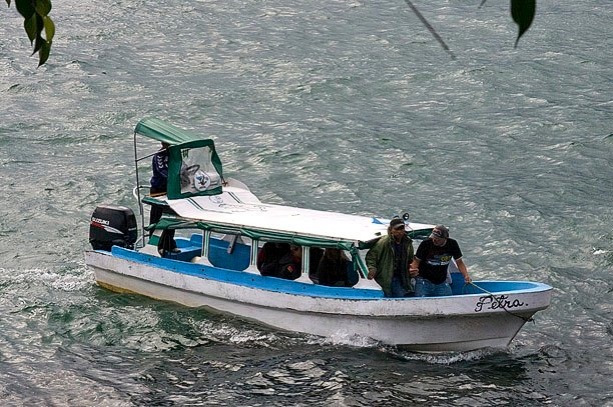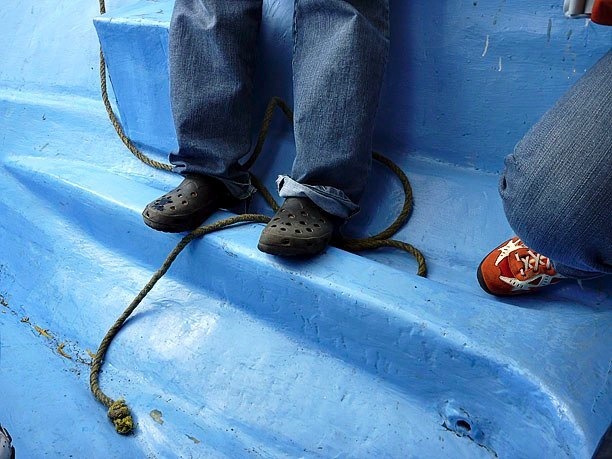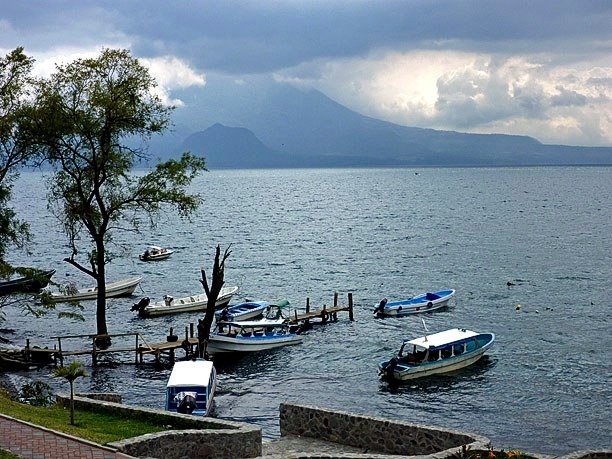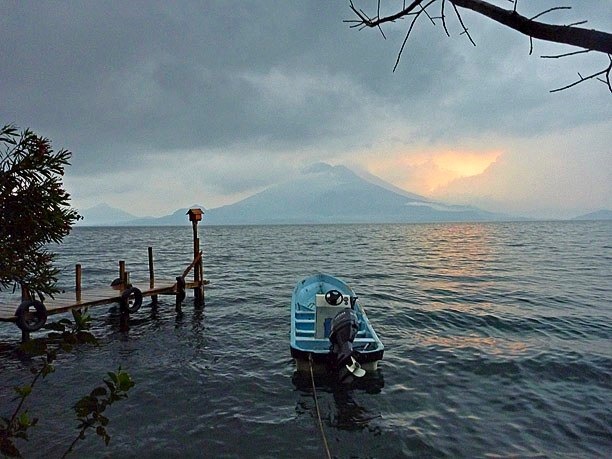 The Mayan crew, pounding the boat across Lake Atitlan, just ahead of a storm.
The Mayan crew, pounding the boat across Lake Atitlan, just ahead of a storm.
I’ve started on the toe rails, and hope to have progress to report soon, once I get it figured out.
In the meantime, here’s some boat related reporting from our trip to Guatemala. Coming from such a car-centric culture, the widespread use of boats for transportation there was fascinating; not only the extent of it, but the types and their construction, as well.
On our first full day in Guatemala we went directly to Lake Atitlan in the western highlands. Lake Atitlan fills the crater of a volcanic caldera, left after a massive explosion 84,000 years ago. The explosion blasted 72 square miles of earth and ash into the air, leaving a gaping hole whose actual depth is still unknown. Looming over the lake are dramatic cones of more recent volcanoes, and the combination of deep blue water and high mountain peaks make this one of the most beautiful places I’ve ever seen.
A clear calm morning, Casa del Mundo’s private launch and dock
on the north shore. Volcan San Pedro in the distance, a town
of the same name known locally as “Gringo Town” – on it’s flank.
Lake Atitlan is well over 1000 feet deep; so deep that, though it’s surface area is relatively small, it contains more water than any other lake in the country. Mornings are normally clear and calm, but as the land heats up the wind builds out of the west from the Pacific. By mid-afternoon the water can be quite rough. This pattern repeats day after day.
The lake has no natural outlet (it was blocked by a volcano), so the water level rises and falls with fluctuations in annual rainfall, or in some cases, fracturing of the lake floor by earthquakes. Two large hurricanes in the last decade have raised the lake a dozen or more feet, submerging terraces and buildings along the shore, and the water is so clear you can see them intact, well below the surface, like some modern day Atlantis.
Atitlan is a popular destination for foreign tourists, though they tend to stick to towns that specifically cater to them. San Pedro la Laguna, for instance, is known to the locals as “Gringo Town.” But in many of the smaller, quiet, more isolated places along the shore it’s rare to see another tourist.
The main town of Panajachel is on the eastern shore, and it is there the main road terminates. From “Pana,” most travel continues by boat to the many Mayan villages and towns along the shore. Recently a crude road was constructed that encircles the lake and provides some access by land; however, most transportation still occurs over water.
The town docks at Panajachel, Lago Atitlan. These are temporary docks
built on top of the main ones, which are now submerged.
There are two kinds of work boats on Lake Atitlan: Power launches for transportation, and locally made dugout canoes for fishing. Seldom do you see a boat here used strictly for pleasure. Except for a couple of bizarre excursion extravaganzas which I never saw leave the docks, these are the only two types of boat I saw on the lake. Because the water can be so rough, the fiberglass boats favored here emulate the unusual high-peaked bows so distinctive on the cayucos. It’s a cool kind of style harmonic between old and new.
 The launch arrives, with French passengers.
The launch arrives, with French passengers.
The first type you encounter at Panajachel are the launches – large, open fiberglass outboards, usually with a partial roof for protection from sun and rain. These are the commuter buses of Atitlan, used by locals and tourists alike. All are privately owned, and prices are eminently negotiable. The more people you can combine on one trip, the lower the price for all, as the price of fuel sets a baseline for operating costs.
 Rough water, rough boarding, and a careful crew.
Rough water, rough boarding, and a careful crew.
The men who operate the launches speak a distinct Mayan language (one of almost two dozen within Guatemala alone), some Spanish, but very little English, so we were glad Scott and Betty could translate and negotiate. It’s an important economy protected by the residents, so if you connect with someone in town who grew up there (and you’ve tipped them well for lunch) they will arrange a boat for you with an honest friend or relative.
Karma and courtesy go a long way in your favor. Our first boat was the only one I saw with enough life preservers on board for every passenger. Well, actually, the only boat I saw with ANY life preservers. But the crew on all our boats were always careful to make sure we were comfortable and left their hands in one piece.
The crew spoke a local Mayan language with each other and passengers from the villages, probably Kaqchikel (spellings are phonetic). At least 3 distinct native languages are spoken within the area around Atitlan, in addition to Spanish and English.
 The fiberglass hull, laid up by hand, and finished according to the whims of the owner.
The fiberglass hull, laid up by hand, and finished according to the whims of the owner.
Most of these launches, here and throughout the country, seem to be made from the same mold. Even the few deviations follow a similar pattern. I was told some of the boats are made in Guatemala City while others are made locally, laid up by hand, probably in a mold taken from another boat. Each boat captain seems to start with the same bare hull, then adds the canopy, seats, etc., using whatever materials and design notions are readily at hand. There’s a very ’70’s feel to the styling on most boats. Some of them may be that old.
Shark mouth decor.
It was already late afternoon by the time we boarded our boat and the wind had kicked up on schedule. To top it off, there was a storm blowing in over the mountains. It made for a rough ride. But these guys know this lake, and they know their boats. So well, in fact, that docking, transferring passengers and gear, all are done even in rough conditions with only provisional use of dock lines. After a couple of touch-and-go dockings in small villages, they charged across the lake toward the village of Jaibalito, then tied up at the Casa del Mundo pier long enough to set us and our gear at the foot of the cliffside hotel, just before the storm hit.
 Disembarking at Casa del Mundo.
Disembarking at Casa del Mundo.
After the storm, the twin volcanic peaks of Toliman and Atitlan appear
through the clouds like a double exposure, one the shadow of the other.
Here’s a short video of the trip across:
The settled places around the shore range from a true small Mayan city, Santiago Atitlan, to small towns and villages, down to one or two private homes or a single hotel tucked in a cove. Some places have accommodations for travelers; others, the smaller villages, only serve the local residents, and have almost a neighborhood feel.
However, it’s the local residents who work in the hotels and restaurants around the lake, and most don’t live where they work, so the morning and evening commute makes for a brisk rush hour of busy activity on the lake. It was fun to watch. Here’s a short video of one morning’s transition:
melonseed skiff, mellonseed skiff, melon seed, mellon seed









Hi, I live here in Panajachel on Lake Atitlan in Guatemala. As you may have heard, there is a serious problem with raw sewage going into the lake. I am an engineer by education and working here as a school teacher. I am starting a project to build small composting toilets that will fit in a normal bathroom. It is my goal to use them as a replacement for the existing flush toilets since there are no properly operating sewage treatment plants here to support flush toilets. I want to make this into a local business that employs the local people. I am wondering if you can point me towards information about how the fiberglass launchas are built. It seems to me that there is already local expertise and a source of materials here for that technology. Hence, I would like to take advantage of that for this project.
Hi Daniel. I don’t actually know where those boats are built, and since I’m based in the US, do not have ready access to that sort of local knowledge. However, the boats are so ubiquitous I don’t imagine it would be too hard to find out, if you could ask someone locally. From what I could surmise by looking at them, I would bet they are constructed by someone in the region, probably in a fairly small operation. Maybe even on demand only when an order is placed.